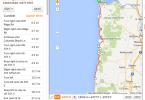WEA Wireless Emergency Alert Cell Broadcast
Note that most if not everyone who possesses a cell phone will get a “Wireless Emergency Alert” (WEA) TEST today after 2:18pm.
Very interesting to see what comes of this new system. Perhaps the President will use it for good.
You never know, right?
Here’s more about this fruity system:
Wireless Emergency Alerts (WEA)
The Wireless Emergency Alerts system is an essential part of America’s emergency preparedness. Since its launch in 2012, the WEA system been used more than 40,000 times to warn the public about dangerous weather, missing children, and other critical situations – all through alerts on compatible cell phones and other mobile devices.
WEA is a public safety system that allows customers who own certain wireless phones and other compatible mobile devices to receive geographically-targeted, text-like messages alerting them of imminent threats to safety in their area.
WEA enables government officials to target emergency alerts to specific geographic areas – lower Manhattan, for example.
WEA was established in 2008 pursuant to the Warning, Alert and Response Network (WARN) Act and became operational in 2012.
Wireless companies volunteer to participate in WEA, which is the result of a unique public/private partnership between the FCC, FEMA and the wireless industry to enhance public safety.
FAQs about WEA
- How does WEA work?

Authorized national, state or local government authorities may send alerts regarding public safety emergencies – such as evacuation orders or shelter-in-place orders due to severe weather, a terrorist threat or chemical spill – using WEA.
The alerts from authenticated public safety officials are sent through FEMA’s Integrated Public Alert and Warning System (IPAWS) to participating wireless carriers, which then push the alerts to mobile devices in the affected area.
- Who receives the alerts?

Alerts are broadcast to coverage areas that best approximate the zone of an emergency. (Beginning November 30, 2019, participating wireless providers must improve geo-targeting of alerts even further.) Mobile devices in the alert zone will receive the alert. This means that if an alert is sent to a zone in New York, all WEA-capable mobile devices in that zone can receive the alert, even if they are roaming or visiting from another state. In other words, a customer visiting from Chicago would receive alerts in New York so long as they have a WEA-enabled mobile device in the alert zone.







